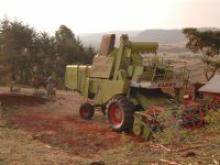Labour-saving technologies and practices: manual and motorised threshers
The process of separating the grain from the ear or panicle (the most energy intensive operation); sorting the grain from the straw; and winnowing the chaff from the grain is called threshing. This practice explains how threshing works, as well as its advantages and disadvantages.
Description
Threshing involves two distinct operations.
- Manual separation methods
The crop is usually beaten on the ground with a flail, or a handful of straws and ears are beaten against a wooden frame or the edge of a container. Output per person is around 20 to 40 kg per hour.
- Separation methods using cattle
The crop is either trampled on the ground by the cattle or a heavy rolled implement being pulled behind them to increase the work rate. Without the pulled implement, the output is roughly the same as the manual method. However, even though it reduces the drudgery, it can lead to increased impurities and damage to the grain.
1. Features of mechanized threshing for small grain crops
1.1 Hand-fed mechanized threshing
- Used when whole, undamaged straw is valuable for basket or mat weaving.
- The simplest are treadle-operated peg-drum threshers; motorized versions are also available.
- They are mainly used for rice but can also be used for sorghum and other crops.
- Outputs for the manually powered machines vary from 100 to 150 kg per hour.
1.2 Through-flow threshers
- The whole crop is forced between a rotating drum and a concave surface, which separates the grain from the straw.
- Consequently, they require much more power.
- Outputs for the motorized machines range from 500 to 2 000 kg per hour and this usually includes both the separating and the winnowing operations.
- There are two types of through-flow threshers, tangential and axial flow machines.
- The latter are generally more efficient at separating the grain from the straw, especially at high loading.
1.3 Straw walkers
- Straw walkers are frequently used after the threshing drums to separate the remaining grain from the straw.
- For hand-fed machines, where the feeding rate is not constant, straw walkers are usually more efficient at separating the grain from the straw than relying on this being done by the drum and concave.
1.4 Large motorized threshers
- Large motorized threshers have relatively high cost and maintenance requirements and are more suitable for contractor/community operations than individual farmers.
2. Advantages
- Labour-saving
- Reduces labour bottlenecks at peak periods, particularly motorized equipment.
- Livelihood diversification
- Income generating opportunities if motorized equipment operated by community group or contractor.
- Livelihood resilience strengthening
- Clean, undamaged and pest disease free products at the correct moisture content fetch higher prices when sold or assist with preparing the seed for storage or planting.
- Grading of grain or pulses is required for sale and for selecting appropriate seed plates for mechanized planting.
- Equipment
- Manually operated equipment is robust and relatively easy to fabricate, maintain and repair.
- Skills
- Manually operated equipment is simple to operate.
3. Disadvantages
- Labour
- The modest increase in work rates with manually operated equipment may not justify the cost of equipment.
- Livelihood
- Grains damaged during shelling or threshing are more at risk of diseases or pest attack during storage, and fetch lower prices when sold.
- Equipment
- Some motorized threshing equipment may be required for only a short period during the year and lies idle for most of the year.
- Cost and risk
- Relatively high cost for private ownership and hence relatively high financial risk.
- Skills
- Motorized equipment requires some specialist skills in use and maintenance of the machine.
- Risk
- May fail if hire services are introduced into an area where there is insufficient demand to pay for contractual and community-owned services.
- Infrastructure
- Motorised equipment requires an adequate supporting infrastructure.
Figure 1. Combine harvester

©FAO/TECA
4. Agro-ecological zones
- Tropics, warm.
5. Related/associated technologies
- Labour-saving technologies and practices: manual carrying, wheelbarrows, hand carts and bicycles: ID 7312.
- Labour-saving technologies and practices: manual crop processing: ID 7317.
- Labour-saving technologies and practices: manually operated strippers and shellers: ID 7318.
- Draught animal power technologies in East Africa: ID 4535.
- Development of tools for draught animals: ID 4483.
- Labour-saving technologies and practices: draught animal power and implements: ID 7306.
- Improving the productivity of draught animal power in sub-Saharan Africa: ID 4467.
- Labour-saving technologies and practices: draught animal powered and motorised crop processing: ID 7307.
6. Objectives fulfilled by the project
6.1 Labour saving technology (LST)
Motorized equipment reduces the labour needed.
6.2 Pro-poor technology
The practice is simple to apply.
